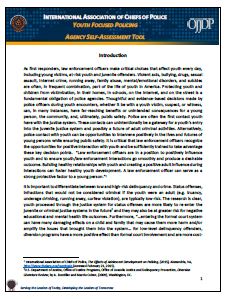IACP: SELF-ASSESSMENT FOR POLICE DEPARTMENTS
Posted by Extreme Tactical Dynamics on Jun 29th 2019
THE IACP YOUTH FOCUSED POLICING AGENCY SELF-ASSESSMENT TOOL
The IACP Youth Focused Policing Agency Self-Assessment Tool is a way that police departments can take an honest, thorough look at their own policies, procedures, and behavior. This Police Department Self-Assessment has been created by IACP in order to give police departments across our nation the opportunity to evaluate their commitment to reducing youth crime, delinquency, and victimization of the young in the cities and towns that they serve. By carefully considering each question as it regards to a particular area of youth involvement, departments will be able to assess their own successes or failures.
Benefits of Taking the Time
The survey identifies the most prevalent juvenile crimes that law enforcement officers have to deal with. Being prepared by being well trained in specific procedures, which are established by tested regulatory policies, help departments deal with all involved in crimes whether they are victims, perpetrators, or law enforcement. Questions in ‘the tool’ single out types of crime as violent acts, bullying, drugs, sexual assault, Internet crime, runaways, abuse, emotional or mental disorders, attempted suicide or suicide. Many of these ‘events’ are often part of a young person’s troubled daily life. Often there is no stability in homes; there is no guidance, and too often juveniles are forced to take on responsibilities of absent adults. Are police departments prepared to handle such social chaos in ways that ensure the welfare of the juvenile?
What can be done by YOUR Police Department to help the youth in the community?….Fill out the Self-Assessment Tool to find out!
 The introduction of the self-assessment offers numerous reasons why the survey should be taken seriously, completed, and used to stimulate improved policies regarding youth issues by law enforcement agencies everywhere...in cities and towns….whether urban or rural.
The introduction of the self-assessment offers numerous reasons why the survey should be taken seriously, completed, and used to stimulate improved policies regarding youth issues by law enforcement agencies everywhere...in cities and towns….whether urban or rural.
By answering a sequence of questions, it will become clear whether a policing community has clear objectives or strategies in place to deal with high-risk delinquency and crime. The focus of many questions is placed on revealing the procedures used when dealing with status crimes, those that would not be considered criminal if the youth were an adult, like truancy, underage drinking, running away, and curfew violations.
The objective of the assessment is to help agencies define goals specifically directed at youth welfare because their needs are ever increasing, but there is serious underinvestment in almost all areas associated with youth matters. Hard questions are asked in the survey, questions that are intended to help departments determine their strengths and weaknesses when dealing with juveniles in trouble. All police departments can benefit, to varying degrees, from thorough self-evaluations and closer looks at their practices and policies when handling kids.
More importantly, research has shown that when youth are dealt with in a highly negative way for status offenses there is a direct impact on them, and they are more likely to re-enter the juvenile or criminal justice systems in the future. Therefore, agencies MUST identify, assess, understand, and respond effectively and in a positive way because it is proven to make a difference.(1)
So...What Kinds of Questions are asked in the IACP Self-Assessment Tool?
Does your agency have a mission statement with clearly defined goals regarding youth? What are its youth policies and procedures? Who deals with kids in your department? What is so helpful about this assessment is that by asking very specific questions in defined areas, a department can quickly ‘see’ what it has done ‘right’...and what it still really needs to do.
Complete the assessment to find out if your department has a ‘good’ youth information database. If the agency doesn’t, there are practical sections after each set of questions that offer suggestions on how to set one up. Collection of accurate data is crucial so that evidence based programs can be created from statistically researched information, and then programs can be evaluated for their success rates.
By providing a measurable way for law enforcement to specifically focus on ‘how’ they deal with youth issues, a clear understanding of what is being done will become apparent. Defects in the system will also become pronounced by honing in on particular types of interactions, making it possible for police departments to ‘zero in’ on weaknesses. Once this is done, a foundation will be in place for developing an action plan that places a priority on protecting and dealing with teens and pre-teens, whether at high-risk or not.
A very strong element of this IACP survey is the detailed summary of suggestions and recommendations provided at the end of each section IF any answers are….NO! This specific guidance per part clearly focuses on how weaknesses in specific areas can be improved. The assessment even provides an Action Plan Template at the end of the survey, so that departments can start developing and implementing their own Youth Focused Policing Programs.
Keep Kids Busy and Out of the Juvenile System
 “…entering the formal court system can have many damaging effects on a child and family that may cause them more harm and/or amplify the issues that brought them into the system… for low-level delinquency offenders, diversion programs have a more positive effect than formal court involvement and are more cost-effective.(2) ”
“…entering the formal court system can have many damaging effects on a child and family that may cause them more harm and/or amplify the issues that brought them into the system… for low-level delinquency offenders, diversion programs have a more positive effect than formal court involvement and are more cost-effective.(2) ”
The challenge is developing and committing to these diversion programs. School sports, clubs, and after-school activities are #1. YMCA and church groups rank high in keeping kids occupied and off the streets as well, but not all communities have after school programs and safe places for kids to have fun. These are prime areas where mentoring can make a real difference in kids’ lives; Rescuing Inner City Students and Kids (R.I.S.K) is such a program. Many churches, civic groups, and police departments around the U.S.A. have established programs that provide ‘positive’ interaction with kids, but our nation needs more organizations dedicated to pro-youth involvement.
Mentoring Programs
There are numerous ways that police can interact with kids and teens in a positive way. Mentoring is at the very top of the list for law enforcement officers when it comes to ways of helping youth; it’s shown to make a real difference in kids’ lives. Many police departments would receive ‘high’ marks in Section 11: Police Operated Programs, Practices and Intervention Activities and in Section 12: Police Involvement in Juvenile Diversion Programs of the assessment because so many officers engage with young people individually, in groups, or with teams, through established programs like Police Athletic Leagues (PAL). New York, Houston, Atlanta, Chicago, just to name a few already have programs in place. Arlington, Texas began an 18 month pilot program in July, 2015, for 7th and 8th grade boys at risk. Because so many police departments are implementing different types of programs, this IACP self-assessment tool comes at just the right time, for it is a crucial aid in helping an agency evaluate the success of its program.
Why is it so important for Police Departments to get this right?
Police have to get this ‘right’ because it is a fundamental obligation of police agencies to protect, especially the most vulnerable, and so often, the very first encounter kids have with the justice system is with the police. “Thoughtful and evidence-based decisions made by police officers during youth encounters, whether it be with a youth victim, suspect, or witness, can, in many instances, have far-reaching benefits or unintended consequences for a young person, the community, and, ultimately, public safety.”(3)
By completing the 23-page self assessment, departments are then ready to begin implementation of their own Youth Focused Policing Programs, guided by Section 13 of the assessment. “Ideally, training courses (would be organized and) would incorporate information about changes in federal, state and local laws, crime, delinquency, and victimization trends for youth, and progress toward agency-wide goals and objectives. All frontline officers should be trained to interact effectively with youth based on adolescent development and trauma-informed approaches to obtain better cooperation from youth, provide better life outcomes for youth, and develop better relations between police and youth in their communities.”(4)
How Evidence Based Assessment Helps
As more and more evaluation is being done on youth related data, collected by official government agencies and associations like the Department of Juvenile Justice and the IACP, a better understanding of juvenile behavior will emerge. By pooling credible assessment data, conducting objective follow ups, and evaluating long-term results, effective, supported research provides significant proof that recommended procedures by agencies DO work. Today results of scientific data collection guide standard practices of engagement by law enforcement when dealing with youth; encounters with them should no longer be just ‘hit or miss’ as it was in the past. One such resource brief was recently published by the IACP: The Effects of Adolescent Development on Policing, (The Teen Brain) in conjunction with the DOJ and Office of Juvenile Justice and other government agencies.
IT’S A WIN-WIN FOR ALL INVOLVED!
 Youth Focused Policing Programs, developed by their own departments, provide police officers with vital guidelines that help them while on patrol or during investigations and arrests or when dealing and communicating with troubled youth. Programs advance numerous ways that law enforcement agencies can perfect their skills in positive ways when interacting with juveniles.
Youth Focused Policing Programs, developed by their own departments, provide police officers with vital guidelines that help them while on patrol or during investigations and arrests or when dealing and communicating with troubled youth. Programs advance numerous ways that law enforcement agencies can perfect their skills in positive ways when interacting with juveniles.
The AICP Self-Assessment Tool will set a law enforcement agency well on its way to establishing successful youth programs and procedures if none are in place, or to fine tune and update those that are. Government law enforcement agencies, police associations, police publications and online magazines, and many police departments nationwide advocate the introduction of youth-oriented policies and multi-level positive involvement because our Youth Matter...They are Our Future. Remember “a law enforcement officer can serve as a strong protective factor to a young person”(5) if the police departments and the police officers ‘GET IT RIGHT!’
RESOURCES:
http://www.arlington-tx.gov/police/mentoring-arlington-youth/
Article Written By K.A.Huffman
Related Posts
- Can Civilians Use Police Flashing Lights?
- Top 5 Emergency Vehicle Lights for Volunteers
- What’s it like to be a Volunteer Firefighter?
- FIRST RESPONDERS AND KIDS at the HOLIDAY SEASON
- Blazing Infernos – California, Oct. 2017
- K9 Police Officers and their Dogs
 Facebook
Twitter
Google+
Instagram
YouTube
Facebook
Twitter
Google+
Instagram
YouTube

